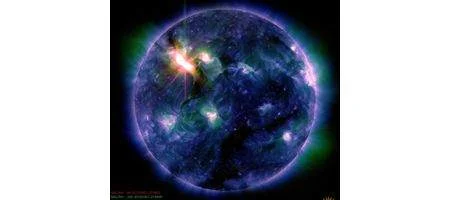One of the biggest solar storms in years is engulfing the Earth, following two flares that erupted on Tuesday.

The first is traveling at more than 1,300 miles per second, and the other almost as fast; NASA models predict that the coronal mass ejections (CMEs) will impact both Earth and Mars. They’ll also pass by the Messenger, Spitzer, and STEREO-B NASA spacecraft.
The first flare, at 7PM EST, was categorized as an X5.4, making it the second largest since the most recent solar minimum in early 2007. About an hour later, the same region – AR 1429 – let loose an X1.3 class flare.
The leading edge of the first CME was predicted to reach Earth at about 1:25 AM EST this morning. It’s been dumping solar particles and magnetic fields into Earth’s atmosphere and distorting Earth’s magnetic fields, causing a moderate geomagnetic storm, rated a G2 on a scale from G1 to G5.
According to NASA, it’s likely to cause aurorae at low latitudes, and may also disrupt high frequency radio communication, GPS and power grids. It’s already caused a temporary radio blackout on the sunlit side of Earth that interfered with radio navigation and short wave radio.
The storm’s already dwindling, but may well ramp up again, says NASA.
In addition, last night’s flares have sent solar particles into Earth’s atmosphere, where they’ve been detected by NASA’s SOHO and STEREO spacecraft, as well as NOAA’s GOES spacecraft.
They’ve produced a moderate solar energetic particle event, also called a solar radiation storm, which is currently rated an S3 on a scale that goes up to S5. NASA’s warning that it may interfere with high frequency radio communication.






